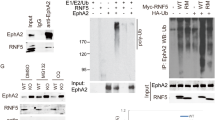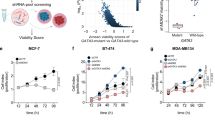Abstract
Heregulin (HRG) is an activator of the erbB2-, erbB3- and erbB4-(erbB-2/3/4) signaling pathway. Transfection of full-length HRG cDNA into the estrogen (E2)-dependent cell line MCF-7 promoted an invasive E2-independent phenotype, as well as persistent activation of the erbB-2/3/4 receptors. Moreover, HRG expression in MCF-7 cells renders the cells sensitive to the topoisomerase II inhibitor doxorubicin (Doxo). In an attempt to dissociate the tumorigenic effect of HRG from the sensitizing effect to chemotherapy, we constructed a structural deletion mutant of HRG. Transfection of the deletion mutant of HRG described in this study (HRG/M) into MCF-7 cells resulted in the dissociation of the tumor-promoting activity of HRG from the sensitization to Doxo, that is, although the cells did not become more aggressive or E2-independent they became more sensitive to Doxo. HRG/M was unable to autophosphorylate the erbB receptors and did not affect the level of MAPK phosphorylation. Furthermore, the intracellular localization of the protein was different from that of the full-length protein. Our data show that the HRG/M sequences are sufficient to sensitize MCF-7 cells to Doxo, and provide evidence that this sensitization is independent of erbB2 activation.
This is a preview of subscription content, access via your institution
Access options
Subscribe to this journal
Receive 50 print issues and online access
$259.00 per year
only $5.18 per issue
Buy this article
- Purchase on Springer Link
- Instant access to full article PDF
Prices may be subject to local taxes which are calculated during checkout









Similar content being viewed by others
References
Alper O, De Santis ML, Stromberg K, Hacker NF, Cho-Chung YS and Salomon DS . (2000). Int. J. Cancer, 88, 566–574.
Aoyama M, Grabowski DR, Dubyak GR, Constantinou AI, Rybicki LA, Bukowski RM, Ganapathi MK, Hickson ID and Ganapathi R . (1998). Biochem. J., 336(Part 3), 727–733.
Fiddes RJ, Janes PW, Sivertsen SP, Sutherland RL, Musgrove EA and Daly RJ . (1998). Oncogene, 16, 2803–2813.
Grimm S, Weinstein EJ, Krane IM and Leder P . (1998). J. Exp. Med., 188, 1535–1539.
Grunt TW, Saceda M, Martin MB, Lupu R, Dittrich E, Krupitza G, Harant H, Huber H and Dittrich C . (1995). Int. J. Cancer, 63, 560–567.
Harris LN, Yang L, Liotcheva V, Pauli S, Iglehart JD, Colvin OM and Hsieh TS . (2001). Clin. Cancer Res., 7, 1497–1504.
Harris LN, Yang L, Tang C, Yang D and Lupu R . (1998). Clin. Cancer Res., 4, 1005–1012.
Hijazi MM, Thompson EW, Tang C, Coopman P, Torri JA, Yang D, Mueller SC and Lupu R . (2000). Int. J. Oncol., 17, 629–641.
Keir M, Fiddes R, Biggs JC and Kearney PP . (2000). Stem Cells, 18, 422–427.
Krane IM and Leder P . (1996). Oncogene, 12, 1781–1788.
Lessor T, Yoo JY, Davis M and Hamburger AW . (1998). J. Cell Biochem., 70, 587–595.
Li W, Park JW, Nuijens A, Sliwkowski MX and Keller GA . (1996). Oncogene, 12, 2473–2477.
Liu W, Li J and Roth RA . (1999). Biochem. Biophys. Res. Commun., 261, 897–903.
Liu X, Hwang H, Cao L, Wen D, Liu N, Graham RM and Zhou M . (1998). J. Biol. Chem., 273, 34335–34340.
Lupu R, Cardillo M, Cho C, Harris L, Hijazi M, Perez C, Rosenberg K, Yang D and Tang C . (1996). Breast Cancer Res. Treat., 38, 57–66.
Matsumoto Y, Kunishio K and Nagao S . (1999). J. Neurooncol., 45, 37–46.
Mazumdar A, Wang RA, Mishra SK, Adam L, Bagheri-Yarmand R, Mandal M, Vadlamudi RK and Kumar R . (2001). Nat. Cell Biol., 3, 30–37.
Paik S, Bryant J, Tan-Chiu E, Yothers G, Park C, Wickerham DL and Wolmark N . (2000). J. Natl. Cancer Inst., 92, 1991–1998.
Peles E and Yarden Y . (1993). Bioessays, 15, 815–824.
Schaefer G, Fitzpatrick VD and Sliwkowski MX . (1997). Oncogene, 15, 1385–1394.
Talukder AH, Vadlamudi R, Mandal M and Kumar R . (2000). Cancer Res., 60, 276–281.
Tang CK, Perez C, Grunt T, Waibel C, Cho C and Lupu R . (1996). Cancer Res., 56, 3350–3358.
Tsai MS, Hornby AE, Lakins J and Lupu R . (2000). Cancer Res., 60, 5603–5607.
Wang JY, Miller SJ and Falls DL . (2001). J. Biol. Chem., 276, 2841–2851.
Weinstein EJ, Grimm S and Leder P . (1998). Oncogene, 17, 2107–2113.
Weinstein EJ and Leder P . (2000). Cancer Res., 60, 3856–3861.
Xiong S, Grijalva R, Zhang L, Nguyen NT, Pisters PW, Pollock RE and Yu D . (2001). Cancer Res., 61, 1727–1732.
Acknowledgements
This work was supported by a grant from the Komen Foundation for Breast Cancer Research and the Department of Energy under Contract No. DE-AC03-76SF00098 (RL), and the National Cancer Institute of Canada (EA).
Author information
Authors and Affiliations
Corresponding author
Rights and permissions
About this article
Cite this article
Atlas, E., Bojanowski, K., Mehmi, I. et al. A deletion mutant of heregulin increases the sensitivity of breast cancer cells to chemotherapy without promoting tumorigenicity. Oncogene 22, 3441–3451 (2003). https://doi.org/10.1038/sj.onc.1206410
Received:
Revised:
Accepted:
Published:
Issue Date:
DOI: https://doi.org/10.1038/sj.onc.1206410
Keywords
This article is cited by
-
Bisphenol S and Bisphenol A disrupt morphogenesis of MCF-12A human mammary epithelial cells
Scientific Reports (2019)
-
Fatty acid synthase regulates estrogen receptor-α signaling in breast cancer cells
Oncogenesis (2017)
-
Transphosphorylation of kinase-dead HER3 and breast cancer progression: a new standpoint or an old concept revisited?
Breast Cancer Research (2007)



